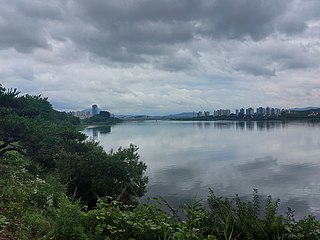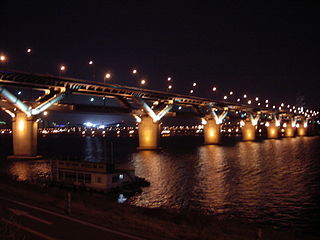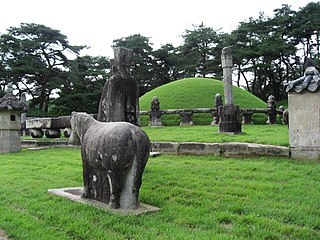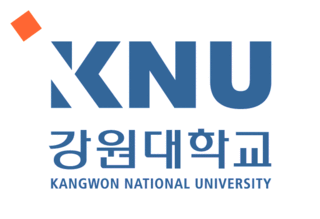| Soyang River | |
|---|---|
 |
The Soyang is a river of South Korea that is part of the Han River system. This river has its source in Inje County, Gangwon, South Korea. [1]
| Soyang River | |
|---|---|
 |
The Soyang is a river of South Korea that is part of the Han River system. This river has its source in Inje County, Gangwon, South Korea. [1]

Chuncheon is the capital of Gangwon Province in South Korea. The city lies in the north of the county, located in a basin formed by the Soyang River and Han River. There are some large lakes around the city, most notably Soyang Lake and Uiam Lake. The area has small river islands, such as Sangjungdo, Ha-Jungdo, Bungeodo, and Wido.

Gapyeong County is a county in Gyeonggi Province, South Korea. It was the scene of the Battle of Kapyong, a major battle of the Korean War.

Yangpyeong County (Yangpyeong-gun) is a county in Gyeonggi Province, South Korea.

Hwaseong Fortress or Suwon Hwaseong is a fortification surrounding the centre of Suwon, the provincial capital of Gyeonggi-do, in South Korea. It was built from 1794 to 1796 by King Jeongjo of the Joseon dynasty to house and honour the remains of his father, Prince Sado. Sado had been executed by being locked alive inside a rice chest by his own father King Yeongjo after failing to obey a command to commit suicide. Located 30 kilometres (19 mi) south of Seoul and enclosing much of central Suwon, the fortress includes King Jeongjo's palace Haenggung. The fortress and enclosed palace were designated as a World Heritage site by UNESCO in 1997. It comprises among many other features the palace, a perimeter wall, four main gates, and two sluicegates over the Suwoncheon, Suwon's main stream, which flows through the centre of the fortress.

Tancheon (Korean: 탄천) is a stream in Gyeonggi Province and Seoul, South Korea. The stream is a tributary of the Han River. It begins in Yongin, Gyeonggi Province, flows through Seongnam, and eventually into the Han. It has a total length of 35.6 kilometres.

Cheongdam Bridge is a bridge over the Han River in Seoul, South Korea. It is the 18th bridge to be constructed over the river. The bridge links the Gwangjin and Gangnam districts. It carries a section of Line 7 of the Seoul Subway, between Cheongdam Station and Ttukseom Resort Station, on its underside, making it the first "duplex bridge" in South Korea. The road portion is a part of the Dongbu Expressway, which limits the bridge to motor traffic only.

The Tombs of the Joseon dynasty refers to the 40 tombs of members of the House of Yi, which ruled Korea between 1392–1910. These tombs are scattered over 18 locations across the Korean Peninsula. They were built to honor and respect the ancestors and their achievements, and assert their royal authority. The tombs have been registered as an UNESCO World Heritage Site since 2009. Two other Joseon tombs, located in Kaesong, North Korea, were proposed but not submitted.

The Bukhan is a tributary of the Han River that flows through both North and South Korea. It traverses Kangwon province in North Korea and Gangwon and Gyeonggi provinces in South Korea.

Kangwon National University is one of ten Flagship Korean National Universities in Gangwon, South Korea. Established as Kangwon Provincial Chuncheon Agricultural College in 1947 in Chuncheon, it extended to a comprehensive university in 1978.
Yeongdong Bridge is a bridge over the Han River in Seoul, South Korea. The bridge links the Gwangjin and Seongdong districts north of the river to Gangnam district. It was opened on November 8, 1973.
Wangbangsan is a mountain in Gyeonggi-do, South Korea. It lies between the cities of Pocheon and Dongducheon. It has an elevation of 737 m (2,418 ft).

The Jamsil Bridge (Korean: 잠실대교) crosses the Han River in South Korea and connects the districts of Songpa-gu and Gwangjin-gu. Completed in 1972, it is the 6th bridge to be constructed over the Han River.

The Gwangjin Bridge crosses the Han River in South Korea and connects the districts of Gwangjin-gu and Gangdong-gu. The original bridge was completed in 1936, but because of deteriorating conditions, it was rebuilt and reopened in November 2003.

The Cheonho Bridge crosses the Han River in South Korea and connects the districts of Gangdong-gu and Gwangjin-gu. The bridge was completed on July 5, 1976. The bridge was built to relieve the heavy traffic on the Gwangjin Bridge, but by 1986 the bridge was experiencing much traffic itself. This was resolved by building the Olympic Bridge in 1988.

The Misa Bridge crosses the Han River in South Korea and connects the cities of Hanam and Namyangju. It is part of the Seoul-Chuncheon Expressway.

Tangeum Lake is an artificial lake at Chungju in South Korea.

The Soyang Dam, also referred to as the Soyanggang Dam, is an embankment dam on the Soyang River, 10 km (6 mi) northeast of Chuncheon in Gangwon-do Province, South Korea. The purpose of the dam is flood control, water supply and hydroelectric power generation. Construction on the dam began in 1967 and was complete in 1973. The 123 m (404 ft) tall dam withholds a reservoir of 2,900,000,000 m3 (2,351,068 acre⋅ft) and supplies water to a 200 MW power station.

The Battle of the Soyang River, also referred to as the "May Massacre", or Battle of Hyeon-ri in Korean and Chinese was fought during the Korean War between United Nations Command (UN) and the Chinese People's Volunteer Army (PVA) and Korean People's Army (KPA) during the Spring Offensive of April–May 1951. The attack took place across the entire front but with the main thrust below the Soyang River in the Taebaek Mountains. The objective of the main effort was to sever the six Republic of Korea Army (ROK) divisions on the eastern front from the remainder of the US Eighth Army and annihilate them and the US 2nd Infantry Division. Secondary attacks would be mounted by PVA and KPA forces across the entire front.

The UN May–June 1951 counteroffensive was a military operation performed by the United Nations Command (UN) during the Korean War launched in response to the Chinese spring offensive of April-May 1951. It was the final large-scale offensive of the war that saw significant territorial changes.

ROKS Soyang (AOE-51) is a fast combat support ship of the Republic of Korea Navy; she is named after the Soyang River.
37°53′48″N127°43′23″E / 37.89667°N 127.72306°E